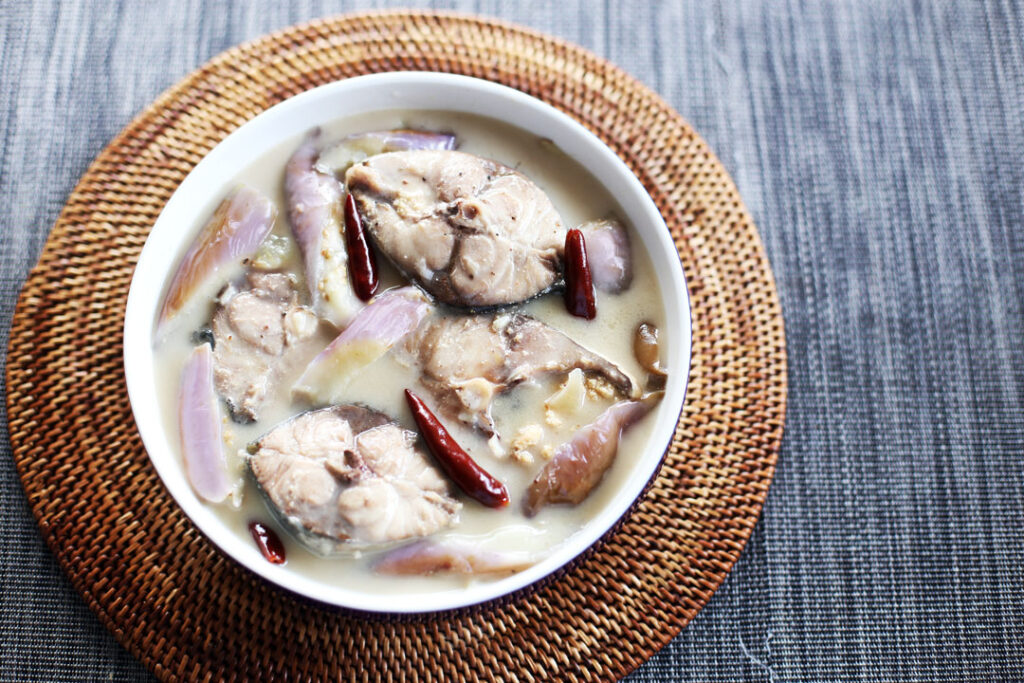If you ask a Filipino what comfort food tastes like, many will say it’s something cooked in gata rich coconut milk that transforms simple ingredients into creamy perfection. Among these dishes, one stands out for its unique flavor and heartwarming simplicity: ginataang tulingan.
This ginataang tulingan recipe shows how a humble fish, simmered slowly in coconut milk, becomes a dish that feels both rustic and special. Whether you’re a beginner or a home cook craving something authentic, this recipe will bring the taste of the Philippines right to your table.
What Is Ginataang Tulingan?
Ginataang tulingan is a traditional Filipino dish made from tulingan, also known as skipjack tuna, cooked in gata (coconut milk) with ginger, garlic, onions, and chilies. The dish is famous in Southern Luzon, especially in Batangas, where coconut trees and fresh fish are abundant.
The combination of creamy coconut milk and the strong, meaty flavor of the fish creates a perfect balance. The coconut milk softens the natural taste of the tuna, while vinegar and spices cut through the richness. Many Filipinos describe it as comfort in a bowl.
History and Cultural Significance
Like most Filipino recipes, ginataang tulingan began as a way to make the most out of local ingredients. Fishermen often brought home small tunas, and families used gata, which was plentiful, to cook them into hearty meals.
In Batangas, this dish holds cultural importance. Locals even celebrate “Tulingan Festival” to honor their fishing heritage. What makes ginataang tulingan timeless is its simplicity: fresh fish, freshly squeezed coconut milk, and a pinch of creativity.
Ingredients You’ll Need
To make this ginataang tulingan recipe, prepare these fresh, local ingredients. If you can’t find tulingan, you can use mackerel, tuna belly, or bangus (milkfish) as alternatives.
| Ingredient | Quantity / Notes | Purpose |
|---|---|---|
| Tulingan (Skipjack Tuna) | 1 kg, cleaned and sliced | Main protein |
| Coconut milk (Gata) | 2 cups | Gives creamy texture |
| Vinegar | ⅓ cup | Removes fishy smell |
| Ginger (Luya) | 1 thumb-sized piece | Adds warmth and aroma |
| Garlic | 4 cloves, chopped | Boosts flavor |
| Onion | 1 medium, sliced | Sweetness and depth |
| Green Chilies | 3–5 pieces | Adds mild heat |
| Eggplant (Talong) | 1–2, optional | Soaks up flavor |
| Fish Sauce (Patis) | 2 tbsp | Salty seasoning |
| Salt and Pepper | To taste | Balances the flavor |
Step-by-Step Ginataang Tulingan Recipe

Making ginataang tulingan is straightforward but requires patience. The secret lies in slow simmering allowing the gata to thicken and the flavors to blend beautifully.
Step 1: Prepare the Fish
Clean the fish thoroughly. Remove the tail and innards, then rinse with water and a little vinegar to remove odor. Make shallow cuts along the body to let the flavors seep in.
Step 2: Boil with Vinegar and Aromatics
In a pot, layer the fish, garlic, onion, and ginger. Pour the vinegar and add a bit of water (about ½ cup). Cover and simmer over medium heat for 10 minutes. This step removes the raw fish smell and firms up the meat.
Step 3: Add Coconut Milk (Gata)
After the vinegar mixture reduces, pour in the coconut milk. Add chilies and eggplants if you’re using them. Simmer on low heat — don’t stir too often or the coconut milk might curdle.
Step 4: Season and Simmer
Add fish sauce, salt, and pepper. Keep the heat low and cook for another 15–20 minutes until the sauce thickens and the oil from the coconut begins to separate. That’s how you know it’s ready!
Step 5: Serve Hot
Serve your ginataang tulingan with warm white rice. The creamy sauce, mixed with rice, is pure Filipino comfort food.
Cooking Tips for the Perfect Ginataang Tulingan
Every Filipino household has its version of this ginataang tulingan recipe. Here are some useful tips to make yours stand out:
- Always use fresh tulingan for the best flavor. Frozen fish tends to lose texture.
- If you prefer a thicker sauce, use coconut cream instead of coconut milk.
- To make the dish spicier, slice the chilies before adding them to the pot.
- Don’t overcook the fish; the meat should remain firm yet tender.
- For a richer taste, add a bit of pork fat or dried shrimp paste (bagoong) during cooking.
Nutritional Facts
Aside from its wonderful taste, ginataang tulingan is packed with nutrients. It’s high in protein, iron, and omega-3 fatty acids, making it both delicious and healthy.
| Nutrient | Per Serving (1 cup) | Benefit |
|---|---|---|
| Calories | 260 kcal | Provides energy |
| Protein | 18 g | Builds muscles |
| Iron | 8 mg | Helps prevent anemia |
| Fat | 14 g | Good fats from coconut |
| Omega-3 | 2.1 g | Supports heart health |
Regional and Modern Variations
Across the Philippines, ginataang tulingan takes on regional twists. In Batangas, some families add kamias (bilimbi fruit) for extra tang. In Bicol, where spicy food reigns, they mix in labuyo chilies and malunggay leaves for color and flavor.
Modern Filipino chefs are giving this dish a twist too. Restaurants in Manila now serve air-fried tulingan in coconut cream or betamax-style tulingan skewers glazed with sweet chili sauce. Despite these innovations, the heart of the dish remains the same — a celebration of gata and community cooking.
Common Questions About Ginataang Tulingan
Q: Can I use canned tuna for this recipe?
A: You can, but fresh tulingan gives better texture and flavor.
Q: How do I keep the coconut milk from curdling?
A: Keep the heat low and stir gently. Avoid boiling too hard.
Q: Is ginataang tulingan spicy?
A: Traditionally, it’s mildly spicy, but you can adjust the chilies to your liking.
Final Thoughts
This ginataang tulingan recipe shows the beauty of Filipino cuisine simple ingredients, slow cooking, and a flavor that speaks of home. It’s not just a meal; it’s a tradition passed down through generations.





